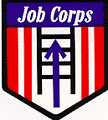 |
The Career Development Service System, CDSS, specifies the four phases of the Job Corps program from Admissions through Placement. These four phases are Outreach and Admissions (OA), Career Preparation Period (CPP) getting acclimated and started, Career Development Period (CDP) vocations and academics, Career Transition Period (CTP) Job Search and Placement. |

Regulations require that those who enroll should be sent to a Job Corps center closest to their home. There are some circumstances in which new students may be sent to a distant Job Corps Center.
All applicants receive services from admissions counselors. As part of the application process those not meeting the basic eligibility requirements are guided to other services including those available through the One-Stop Career Center and partner programs.
Personal Career Development Plan (PCDP)
Applicants begin their career development with a goal-setting process guided by their admissions counselors, creating an initial personal career development plan (PCDP) that may be modified, with their participation, throughout their progress in Job Corps. This personal career development plan is the blueprint for the education and vocational training students need to reach their post-Job Corps career goals.
Back to Top

All new students begin their career preparation period with a one week course to learn about the Job Corps Center and various activities. Residential students continue acclimating to living at Job Corps with the help of residential advisors and recreation staff.
All students in the career preparation period learn employability, job search and retention skills and acquire basic information technology and computer skills. These skills are the foundation for future training and ultimately employment.
Students continue to refine their Personal Career Development Plan (PCDP) with staff and visit the One-Stop Career Centers to become acquainted with other career and employment resources. With these basic skills they are ready to move into the Career Development Phase.
Back to Top

After developing the basic skills in CPP students are ready for the career development period or CDP. They achieve academic goals including upgrading skills needed in a particular trade, or earning a general equivalency diploma - the GED, or a high school equivalency diploma. At the San Jose Job Corps Center, students may attend one of the two Charter Schools co-located on center, SIATech (School for Integrated Technologies) or Muir Charter School.
In career development, students learn a trade. There are more than 25 vocational options at the San Jose Job Corps Center, many taught off-campus by programs including the Metropolitan Education District's Central County Occupational Center and Metropolitan Adult Education Program, as well as other workforce development programs. All courses are subject to change. Students may participate in work-based learning to gain practical on-the-job experience.
Students learn additional communication, problem-solving and social skills and continue developing employability, job search and retention, and information technology and computer skills.
Back to Top

Finally, in career transition students begin preparation for transition readiness, including independent living skills, job searching and the start of transition from Job Corps to the workforce. In the career transition period students may also participate in work-based learning opportunities providing them with hands on experience while transitioning from the program.

Graduates who complete Job Corps receive services for 12-months after leaving the program. Students who drop within 90 days receive 3-months of support services after leaving Job Corps. These services are provided by Job Corps' career transition specialists with various services offered both on center and often at area One-Stop Career Centers. This is to assure that career transition specialists work with graduates at the sites where they can easily link the graduates to the array of other resources available at One-Stop Centers. This help can be in many forms, including assistance with housing issues, child care, job search, job retention, additional education or training, and any other issues that may arise.
Back to Top
|



